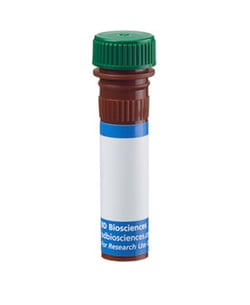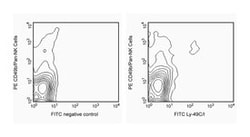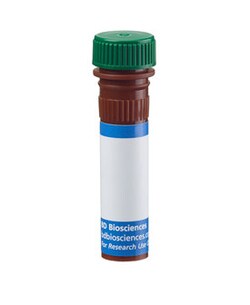Learn More
Ly-49C and Ly-49I Mouse anti-Mouse, FITC, Clone: 5E6, BD
Mouse Monoclonal Antibody
$214.00 - $428.00
Specifications
| Antigen | Ly-49C and Ly-49I |
|---|---|
| Clone | 5.00E+06 |
| Concentration | 0.5mg/mL |
| Applications | Flow Cytometry |
| Classification | Monoclonal |
Description
The 5E6 (also known as clone SW5E6) antibody reacts with Ly-49C[BALB], Ly-49C[B6], Ly-49C[NZB], and Ly-49I[B6], inhibitory receptors which are expressed on subsets of natural killer (NK) cells and NK-1.1+ (or DX5+) T lymphocytes (NK-T cells) in all strains tested except C57BR and RIII, on a population of memory CD8+ T lymphocytes and NK1.1+ γδ T cells in C57BL/6 mice, and on a distinct subset of B-1 cells of BALB/c and C57BL/6 mice. The proportion of NK T cells expressing Ly-49C/I is higher (2-5 fold) in thymus than in liver (immature and mature NK T cells, respectively), and there is evidence that the down-regulation of Ly-49 receptor expression is necessary for normal NK T-cell development. Most NK cells express a single allele of Ly-49C, although occasionally they may express more than one allele. The Ly-49 family of NK-cell receptors are disulfide-linked type-II transmembrane protein homodimers with extracellular carbohydrate-recognition domains (CRD) that bind to MHC class I alloantigens. The Ly-49 family members are expressed independently, such that an individual NK or T cell may display more than one class of Ly-49 receptor homodimers. The 5E6 antibody is specific for the Ly-49C CRD. The Ly-49C[BALB] and Ly-49C[B6] alloantigens bind to MHC class I antigens of the b, d, k, and s haplotypes, and the 5E6 antibody blocks this binding. Binding of Ly-49C[BALB]- and Ly-49C[B6]- expressing transfectants to lymphoblasts of H-2[f], H-2[q], H-2[r], and H-2[v] strains has also been detected. Ly-49I[B6] transfectants bind H-2[r] lymphoblasts and bind much more weakly to the b, d, k, q, s, and v haplotypes. The levels of the Ly-49 inhibitory receptors are down-regulated by their ligands in vivo , and the various levels of expression of an Ly-49 inhibitory receptor may affect the specificity of NK cells. Ly-49C is specifically downregulated in the presence of H-2K[b] class I molecules (one of the Ly-49C ligands). Ly-49C[+] and/or Ly-49I[+] cells mediate allogeneic and hybrid resistance to H-2d bone marrow transplantation. In vitro and in vivo I mmunoreceptor T yrosine-based I nhibitory Motif).
The epitope recognized by this antibody on Ly49C may be masked on freshly isolated primary NK cells due to cis interactions with MHC class I molecules. This observation has been reported for other Ly49C monoclonal antibodies that bind to the same structural region.
Specifications
| Ly-49C and Ly-49I | |
| 0.5mg/mL | |
| Monoclonal | |
| Mouse | |
| Mouse | |
| Activated mouse NK cells | |
| Primary | |
| Store undiluted at 4°C and protected from prolonged exposure to light. Do not freeze. |
| 5.00E+06 | |
| Flow Cytometry | |
| FITC | |
| RUO | |
| Aqueous buffered solution containing ≤0.09% sodium azide. | |
| IgG2a κ | |
| Affinity Purified |
For Research Use Only.
Your input is important to us. Please complete this form to provide feedback related to the content on this product.


